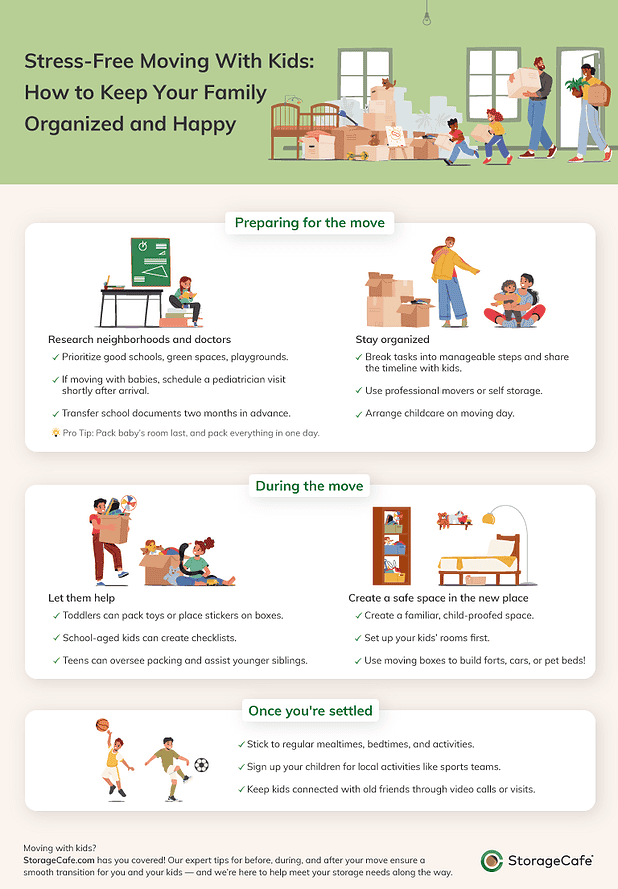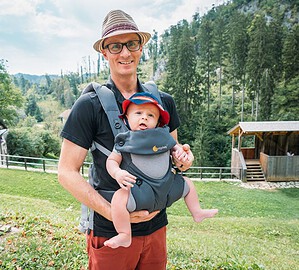Moving is never easy, and when you add kids into the mix, things can quickly get even trickier. Children, especially small ones, love sticking to their day-to-day routine, so the upheaval of packing up and relocating to a new place can be very stressful. Older children might not be as affected by the change in routine, but most of them feel sad about leaving behind their home, neighborhood, friends and school.
However, with a little bit of foresight and planning and a whole lot of patience, you can keep order and harmony in your home and family, even with the stress of moving.

Explain the reasons behind the move
Explain why you’re moving in a way that your children will understand. Naturally, the conversation needs to be adapted to your child’s age, but it’s an important step that shouldn’t be skipped, even with very young kids. A three-year-old is perfectly capable of comprehending most of the reasons behind the decision to move and discussing it with them provides a sense of control. Whether it’s for a new job, a bigger home or to be closer to family, make sure your kids know why you are moving.
Highlight the positive aspects of the move, such as new adventures, a bigger backyard or new opportunities, while also acknowledging their feelings of sadness or worry about leaving behind friends and familiar surroundings. Feeling included in the decision and talking about it helps kids deal easier with all the anxiety related to moving.
Involve them in the packing and moving process
One way to make kids feel more comfortable during a move is to get them involved in every step of the process. Seeing as kids’ comfort revolves around having access to their favorite items, be it toys, books or electronics, it’s a good idea to pack their rooms last. Depending on their age, give them small responsibilities, such as packing their favorite toys or labeling boxes with stickers. Naturally, the older the child, the bigger the responsibilities — if we’re talking teenagers, they should be fully in charge of packing and managing their own belongings throughout the move.
For younger kids, it’s a good idea to let them pack a personal “moving day bag” with their favorite items, like a blanket, stuffed animal or game, to have with them during the transition.
Maintain an uncluttered space throughout the move
Moving and clutter are a package deal, but it’s important to keep some areas of your home free of boxes and chaos, particularly your children’s spaces. Try to maintain their rooms, play areas and favorite spots as organized as possible until the very last moment to maintain a sense of normalcy for them.
It’s difficult to do so when surrounded by boxes and piles of items waiting to be packed. Fortunately, there’s a simple solution to this problem — renting a self storage unit, truly a game-changer in such situations. Try to find one located as close as possible to the home you’re moving to. Store your already-packed boxes and other nonessential items in the storage unit.
This will keep the current home relatively tidy during the packing process, helping your kids feel more comfortable. Another huge advantage is that, come moving day, this strategy gives you a bit of leeway. You have fewer possessions to manage during that busy day. And not only that, but you can also unpack your belongings gradually, bringing back boxes from the storage unit at your convenience. This allows you to organize your new home properly, without the pressure of unpacking dozens of boxes in a short amount of time.
Stick to your regular schedule
A good way to keep the chaos of moving from causing too many tantrums in your home is by sticking to your kids’ normal routine. Meals, bedtimes and family activities should remain consistent to give them a sense of stability. This can be challenging considering the circumstances, but you can take steps to help you stick to a normal schedule, such as meal prepping and setting aside a few hours of “family time” every week.
Set up their new space first
One of the most effective ways to help children adjust to a new home is by prioritizing the setup of their bedroom. Start the conversation early on and ask them how they want their new bedroom to be in terms of paint color and furniture (if new furniture is on the table). Then, as soon as you arrive at the new place, make their space comfortable and familiar. Set up and arrange the furniture according to their preferences, unpack their favorite toys, make the bed with familiar bedsheets and hang up any special posters or decorations. This gives them a sense of ownership and comfort, helping them settle in faster.
Help them embrace the new, but make sure they stay connected with old friends
The transition to a new home, new neighborhood and new school is a major event in your kid’s life. Settling into their new life is essential, but it’s equally important for children to maintain connections with their old friends. Arrange playdates, phone calls or video chats to help them stay in touch. If logistically possible, you could organize a sleepover or a small party at the new house with their old friends, especially during the early days after the move when they might feel isolated. As they settle into the new environment, you can start enrolling them in new activities and encourage them to expand their circle of friends.
Moving with kids is always challenging, but there are steps you can take to alleviate the stress and disruption. Communicate openly, involve them in the process and focus on maintaining routines and creating a familiar environment in the new home. All these steps will help your children adjust more easily to the big changes ahead.




